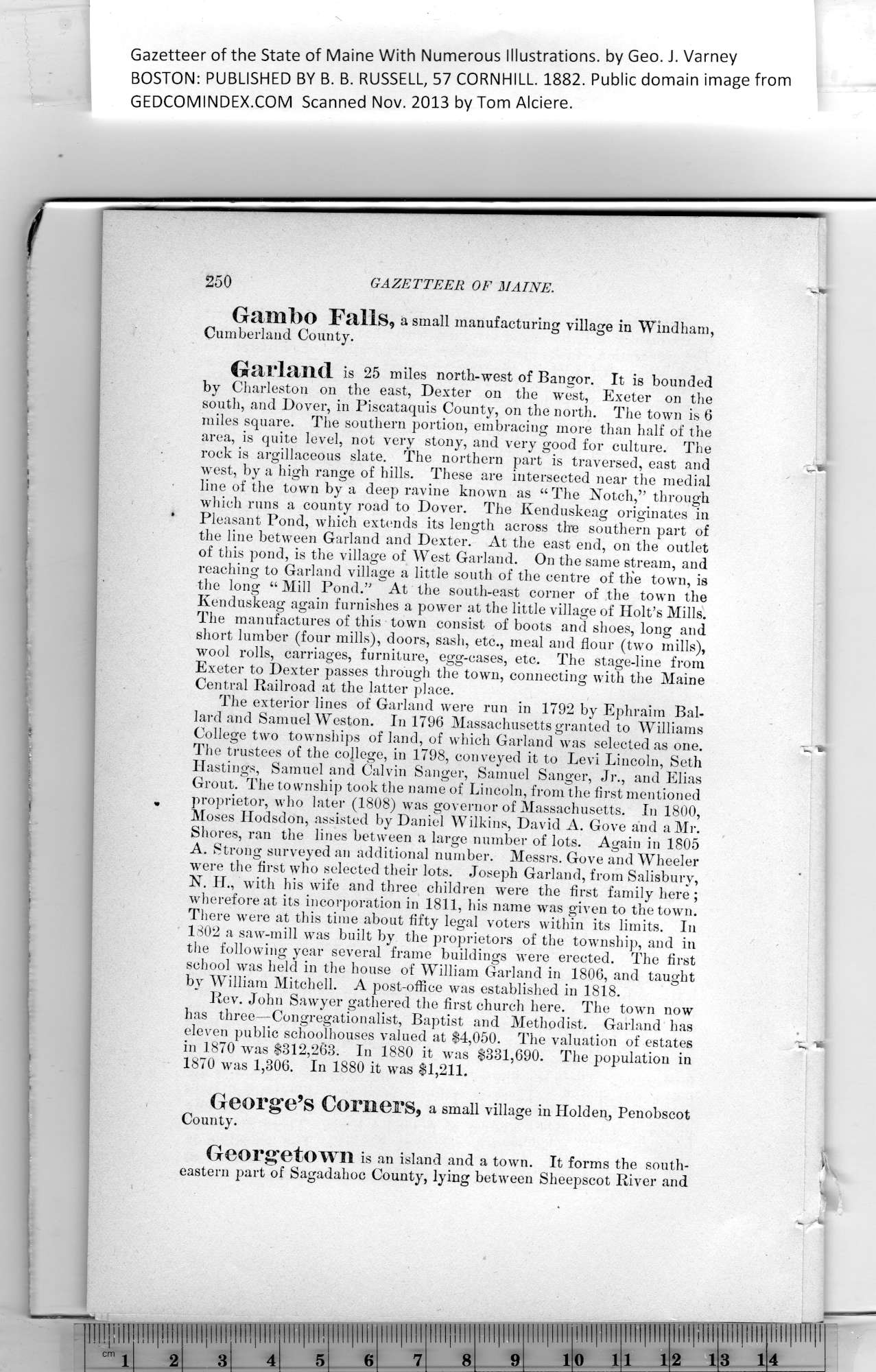|
Gazetteer of the State of Maine With Numerous Illustrations, by Geo. J. Varney
BOSTON: PUBLISHED BY B. B. RUSSELL, 57 CORNHILL. 1882. Public domain image from
Gambo Falls, a small manufacturing village in Windham,
Cumberland County.
Garland is 25 miles north-west of Bangor. It is bounded
by Charleston on the east, Dexter on the west, Exeter on the
south, and Dover, in Piscataquis County, on the north. The town is 6
miles square. The southern portion, embracing more than half of the
area, is quite level, not very stony, and very good for culture. The
rock is argillaceous slate. The northern part is traversed, east and
west, by a high range of hills. These are intersected near the medial
line of the town by a deep ravine known as “The Notch,” through
which runs a county road to Dover. The Kenduskeag originates in
Pleasant Pond, which extends its length across the southern part of
the line between Garland and Dexter. At the east end, on the outlet
of this pond, is the village of West Garland. On the same stream, and
reaching to Garland village a little south of the centre of the town, is
the long “ Mill Pond.” At the south-east corner of the town the
Kenduskeag again furnishes a power at the little village of Holt’s Mills.
The manufactures of this town consist of boots and shoes, long and
short lumber (four mills), doors, sash, etc., meal and flour (two mills),
wool rolls, carriages, furniture, egg-cases, etc. The stage-line from
Exeter to Dexter passes through the town, connecting with the Maine
Central Railroad at the latter place.
The exterior lines of Garland were run in 1792 by Ephraim Bal-
lard and Samuel Weston. In 1796 Massachusetts granted to Williams
College two townships of land, of which Garland was selected as one.
The trustees of the college, in 1798, conveyed it to Levi Lincoln, Seth
Hastings, Samuel and Calvin Sanger, Samuel Sanger, Jr., and Elias
Grout. The township took the name of Lincoln, from the first mentioned
proprietor, who later (1808) was governor of Massachusetts. In 1800,
Moses Hodsdon, assisted by Daniel Wilkins, David A. Gove and a Mr.
Shores, ran the lines between a large number of lots. Again in 1805
A. Strong surveyed an additional number. Messrs. Gove and Wheeler
were the first who selected their lots. Joseph Garland, from Salisbury,
N. H., with his wife and three children were the first family here ;
wherefore at its incorporation in 1811, his name was given to the town.
There were at this time about fifty legal voters within its limits. In
1802 a saw-mill was built by the proprietors of the township, and in
the following year several frame buildings were erected. The first
school was held in the house of William Garland in 1806, and taught
by William Mitchell. A post-office was established in 1818.
Rev. John Sawyer gathered the first church here. The town now
has three—Congregationalist, Baptist and Methodist. Garland has
eleven public schoolhouses valued at $4,050. The valuation of estates
in 1870 was $812,263. In 1880 it was $331,690. The population in
1870 was 1,306. In 1880 it was $1,211.
Georg-e’s Corners, a small village in Holden, Penobscot
County.
Georg-etown is an island and a town. It forms the south-
eastern part of Sagadahoc County, lying between Sheepscot River and
PREVIOUS PAGE ... NEXT PAGE
This page was written in HTML using a program written in Python 3.2
|
